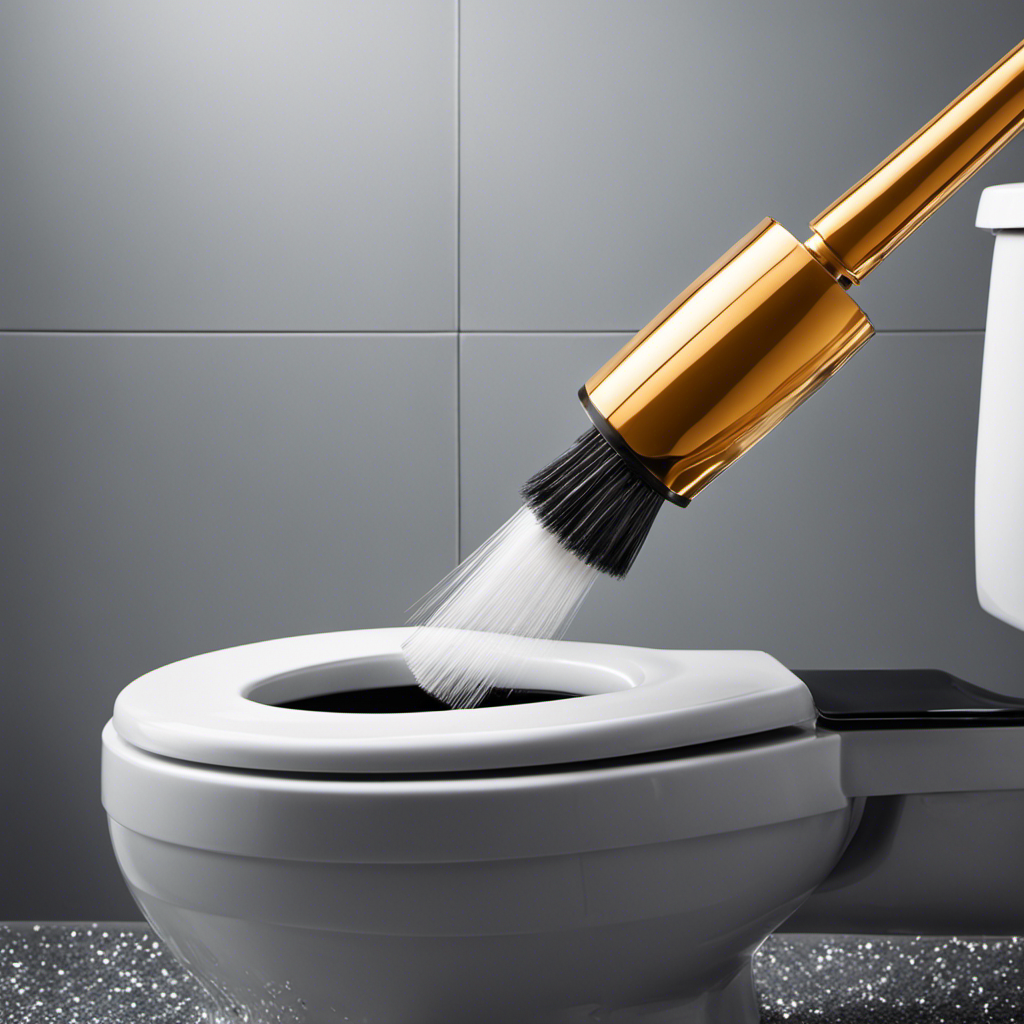Hey there! So, have you ever noticed water leaking from the bottom of your toilet tank when you flush it? It can be a real pain, right?
Well, don’t worry, because in this article, I’m going to share some possible causes of this issue and walk you through the steps to fix it.
We’ll also discuss common mistakes to avoid and when it might be best to call in a professional.
So, let’s dive in and get that toilet tank leak sorted out!
Key Takeaways
- Possible causes of water leaking from the bottom of the toilet tank include a faulty flush valve seal, a cracked toilet tank, a loose or malfunctioning fill valve, and a worn-out flapper.
- To identify if the leak is coming from the tank, one can check for visible cracks or damage on the tank, look for water pooling around the base of the toilet, notice if the toilet is continuously running, monitor any increase in water bills, and observe if water is leaking from the tank.
- Steps to fix a leaking toilet tank include shutting off the water supply valve, flushing the toilet to drain the tank completely, disconnecting the water supply line from the bottom of the tank, and identifying the source of the leak to replace or repair the faulty parts according to manufacturer’s instructions.
- Common mistakes to avoid when repairing a leaking toilet tank are not properly identifying the source of the leak, thinking that the only solution is to replace the entire toilet tank, adding excessive caulk or sealant to fix the leak, ignoring the water level in the tank as a potential cause of the leak, and failing to properly inspect and repair damaged parts.
Possible Causes of Water Leaking From Bottom of Toilet Tank
You might be wondering what could be causing the water to leak from the bottom of your toilet tank when you flush it.
There are a few potential reasons for this issue, which can often be resolved with some simple toilet tank repairs.
One possible cause is a faulty flush valve seal. Over time, this seal can wear out or become misaligned, leading to water leakage.
Another common culprit is a cracked toilet tank. This can occur due to age, improper installation, or even accidental damage.
Additionally, a loose or malfunctioning fill valve can also cause water to leak from the bottom of the tank.
With some basic DIY toilet repairs, such as replacing the flush valve seal or tightening the fill valve, you can often fix these issues and stop the water leakage.
How to Identify if the Leak Is Coming From the Tank
When determining the source of the leak, it’s important to check for any visible cracks or damage on the tank. Signs of a faulty toilet tank can include water pooling around the base of the toilet, a continuously running toilet, or an increase in water bills. Troubleshooting toilet tank leaks involves a systematic approach to identify the exact cause. Here is a visual representation of the possible causes and their corresponding signs:
| Possible Causes | Signs of a Faulty Toilet Tank |
|---|---|
| Cracked tank | Visible cracks or damage |
| Loose or worn-out bolts | Water pooling around base |
| Faulty flapper | Continuously running toilet |
| Faulty fill valve | Increase in water bills |
| Faulty flush valve | Water leaking from tank |
Steps to Fix a Leaking Toilet Tank
To fix a leak in the toilet tank, start by shutting off the water supply valve, usually located behind the toilet. Once the water is shut off, flush the toilet to drain the tank completely.
Next, disconnect the water supply line from the bottom of the tank using an adjustable wrench. Take a look at the tank to identify the source of the leak, which could be a cracked tank, a faulty fill valve, or a worn-out flapper.
Depending on the issue, you may need to replace the tank or repair the faulty parts. If it’s a minor issue, you can try to tighten any loose connections or replace the worn-out parts. Make sure to follow the manufacturer’s instructions for any replacement parts.
Once you have fixed the issue, reconnect the water supply line, turn on the water supply valve, and test the toilet for any leaks.
Common Mistakes to Avoid When Repairing a Leaking Toilet Tank
One common mistake to avoid when fixing a leaky toilet tank is not properly identifying the source of the leak. It is important to understand that the water could be leaking from various places, such as the tank bolts, the flush valve, or the fill valve.
Here are three common misconceptions about toilet tank leaks and common DIY solutions to consider:
-
Misconception: The only solution is to replace the entire toilet tank.
DIY Solution: In many cases, a simple fix like replacing a faulty seal or tightening loose bolts can solve the problem. -
Misconception: Adding more caulk or sealant will fix the leak.
DIY Solution: Applying excessive caulk can actually make it harder to identify and fix the leak. It is crucial to properly inspect and repair the damaged parts. -
Misconception: The water level in the tank is not related to the leak.
DIY Solution: Adjusting the water level in the tank can help prevent leaks by ensuring the proper functioning of the fill valve.
When to Seek Professional Help for a Leaking Toilet Tank
If you’re unsure about fixing a leaky toilet tank, it might be best to seek professional help. While there are DIY solutions for a leaking toilet tank, there are certain signs that indicate a more serious toilet leak that requires the expertise of a professional plumber.
One sign of a serious toilet leak is water pooling around the base of the toilet. This could indicate a faulty wax ring or a cracked toilet base.
Another sign is a constant, steady flow of water into the toilet bowl even when it’s not being flushed. This could be caused by a faulty fill valve or a worn-out flapper.
If you notice any of these signs or if your DIY attempts to fix the leak have been unsuccessful, it’s advisable to call a professional plumber who can accurately diagnose and repair the issue.
Conclusion
In conclusion, when dealing with a water leak from the bottom of a toilet tank, it is important to promptly identify the cause and take appropriate steps to fix it. By following the steps outlined in this article, you can successfully repair the leak and prevent further damage to your bathroom.
Remember, ‘a stitch in time saves nine,’ so addressing the issue early on can save you from costly repairs in the future. If you are unsure or uncomfortable with fixing the leak yourself, it is always best to seek professional help to ensure a proper and lasting solution.










